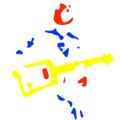This is the first in a series of blogs aimed at demystifying the study of music using methods that I've found effective over many years.
While it can seem overwhelming to start with, in the end it comes down to unravelling the language that musicians use and connecting it to the music you hear, one step at a time.
To understand music theory you need to directly connect new concepts to musical examples you can hear.
All the blabbering on in the world won't make a scrap of difference if there's no actual music involved. Don't put the horse before the cart, you have to listen to musical sounds to have any idea of how they work. The words are only useful if they help you recognise what you are hearing.
Enjoy the journey, forget about the destination.
Music theory is not complicated, in fact it's very simple, but learning it can take time and sometimes sticking with something over a long period of time can seem hard, or at least daunting. It really is however a case of enjoying the journey, if you can do that, and find a journey that is enjoyable, you'll make real progress.
If you're looking for a quick fix then you'll ultimately be disappointed. You've seen the 'Play like a Rock god in 5 minutes' ads, they don't work. Of course they don't work. If you want a quick easy fix I'd suggest you look elsewhere, there are plenty willing to offer that.
To the task at hand
Get your guitar, let's say a three string tuned GDG.
- Play the open string in the middle (D) and listen intently to it, close your eyes and focus on it.
- Stop playing and in silence hear that note back in your head (this is the trick)
- Sing it out loud (or make any noise that resembles the sound in your head)
- Do it again
- and again
- etc.
Once you've got that
- Do the same thing with the note on the first fret of that same string,
- and then the second.
- Now go back to the open string again, play, listen sing.
- Do the same for the note on the second fret.
Keep playing, listening and singing these two notes until you can:
- Play listen and sing D on the open string
- Listen in your head for the E note on the 2nd fret, without playing it
- Sing the E note
- Play the E note to see how close you got. If you missed it play, listen sing again.
- Repeat and rinse
Give yourself time to do this, it won't happen overnight but it will happen with a little practice every day.
They say that the longest journey begins with a single step. This is actually a mistranslation, old Lao Tzu is more accurately quoted as saying that the journey begins from where you are now. This is how learning works, take something that you can do and build on it. You then have a new thing you can do, start from there and keep building.
